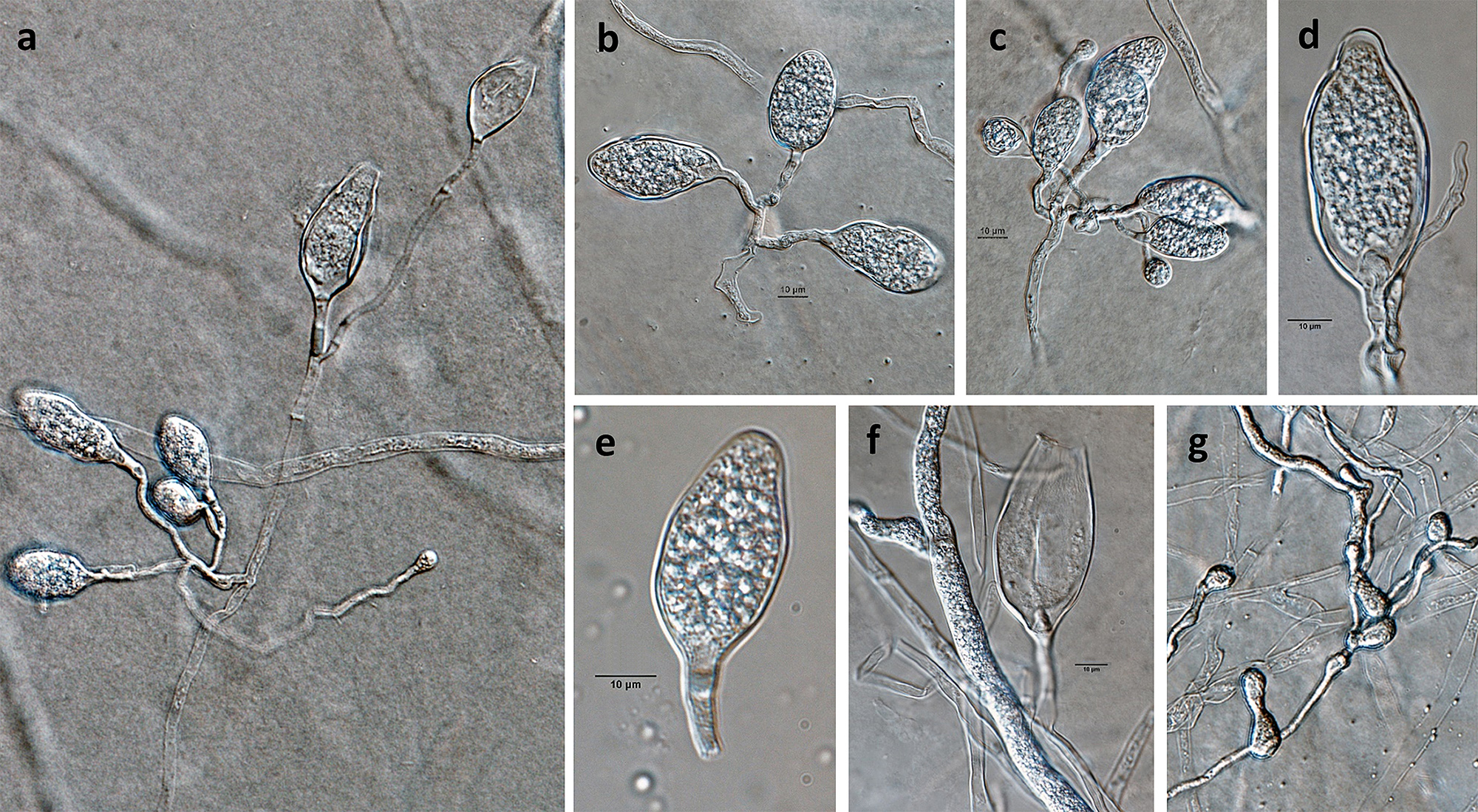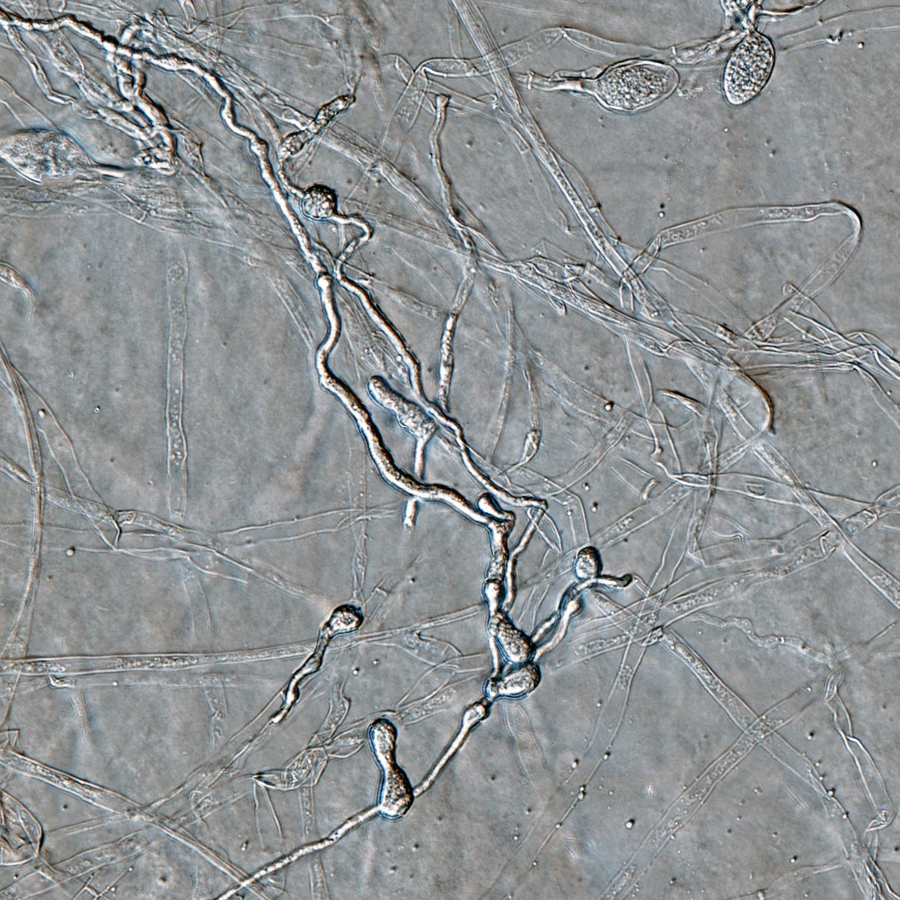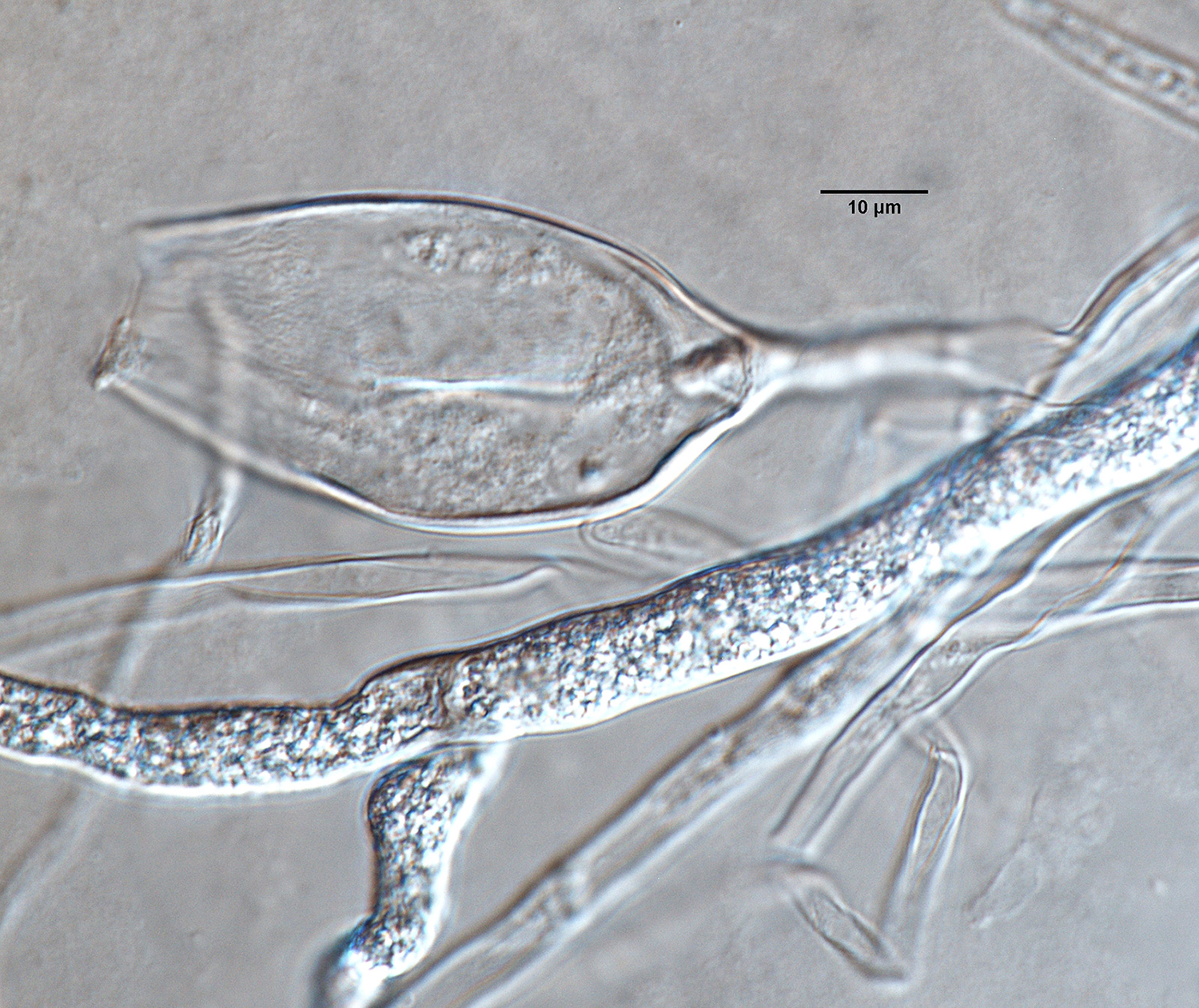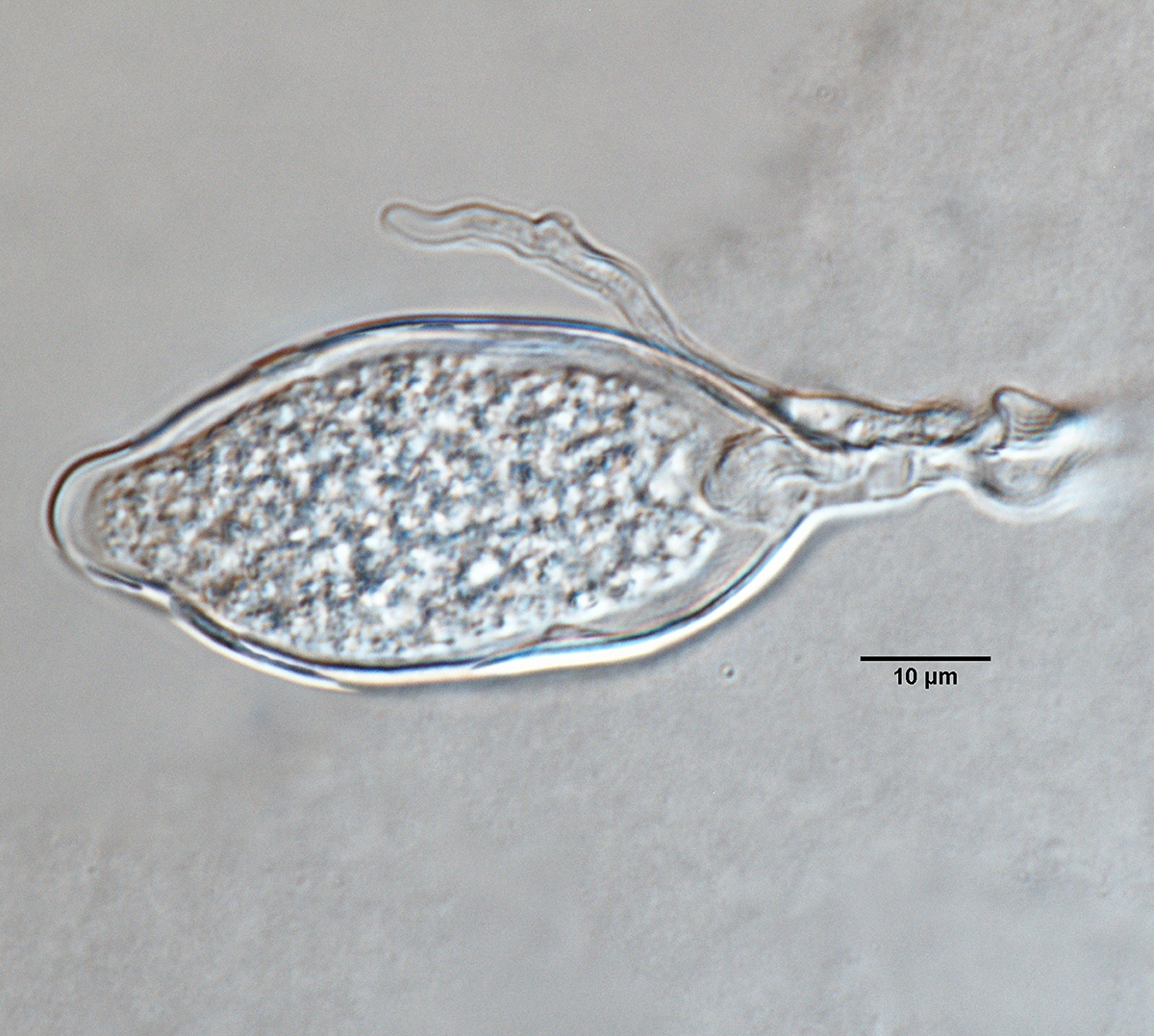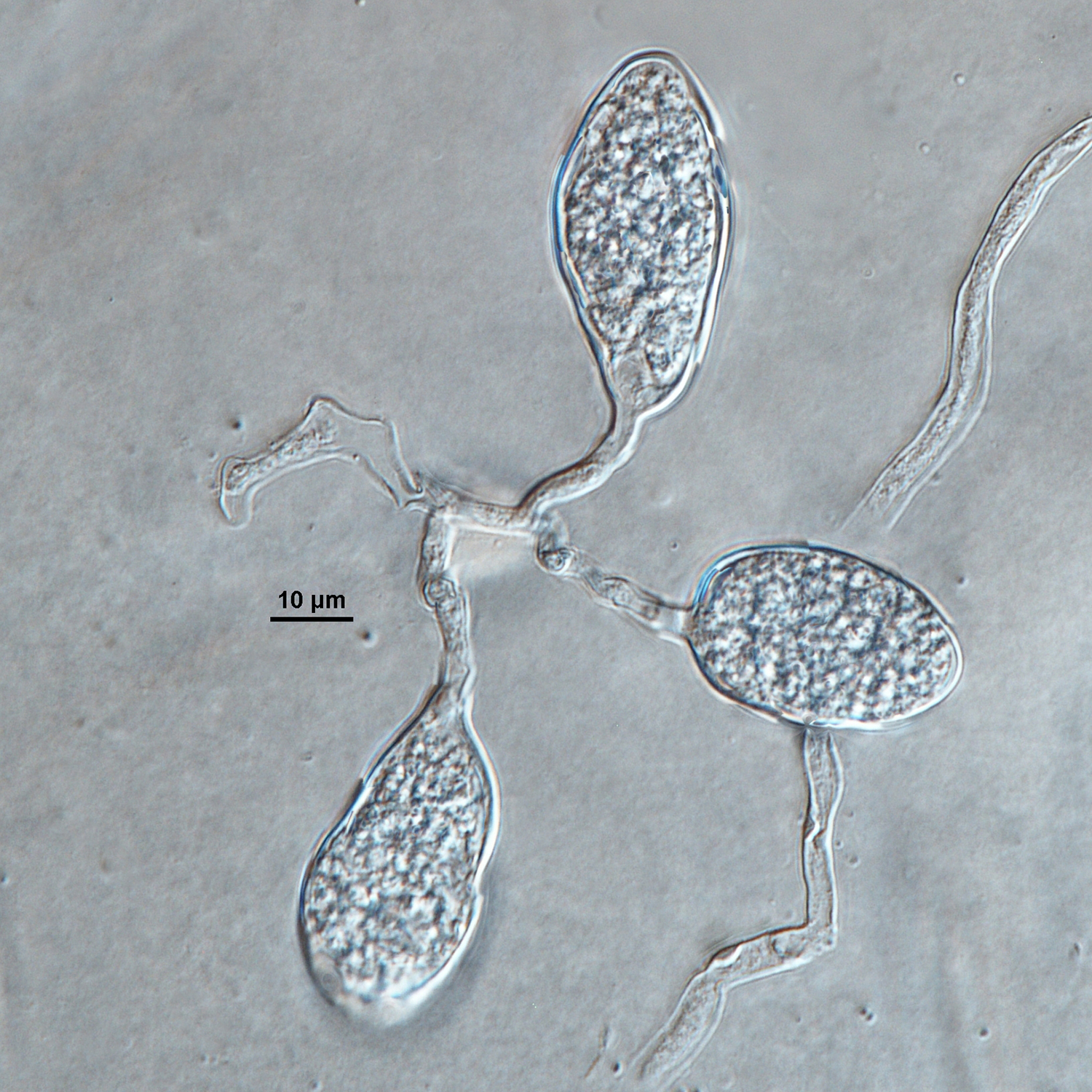Phytophthora porri (in progress - Abad et al. 2023b)
|
Phytophthora spp. in subclade 8b: portion of the seven-loci ML phylogeny featuring the type cultures of 212 described species (by T. Bourret). Notice the position of P. porri selected specimen CBS 116662 = S&T BL 147. Gloria Abad, USDA S&T.
|
|
Phytophthora spp. in subclade 8b: Morphological Tabular key (PDF) and Tabular key legends (PDF) in IDphy2 KEY SECTION. Notice the data of P. porri selected specimen CBS 116662 = S&T BL 147. Gloria Abad, USDA S&T.
|
|
Phytophthora porri (CPHST BL 147) colonies of the selected specimen grown for 7 days on (a) V8® Agar, (b) potato dextrose agar, and (c) malt extract agar; photo by Krysta Jennings and Leandra Knight, USDA-APHIS-PPQ |
|
Phytophthora porri (CPHST BL 147) asexual phase: (a–e) semipapillate persistent sporangia, sometimes with tapered bases, (a–c) sporangia originated in simple sympodial sporangiophores; (e) caducous sporangia rarely observed; sporangium with no internal proliferation; (g) hyphal swellings single or in chains; photos by Gloria Abad, USDA-APHIS-PPQ. |
|
Phytophthora porri (CPHST BL 147) asexual phase: sporangia originated in simple sympodial sporangiophores; photo by Gloria Abad, USDA-APHIS-PPQ. |
|
Phytophthora porri (CPHST BL 147) asexual phase: caducous sporangia rarely observed; sporangium with no internal proliferation; photo by Gloria Abad, USDA-APHIS-PPQ. |
|
Phytophthora porri (CPHST BL 147) asexual phase: hyphal swellings single or in chains; photo by Gloria Abad, USDA-APHIS-PPQ. |
|
Phytophthora porri (CPHST BL 147) asexual phase: sporangium with internal proliferation; photo by Gloria Abad, USDA-APHIS-PPQ. |
|
Phytophthora porri (CPHST BL 147) asexual phase: semipapillate sporangium; photo by Gloria Abad, USDA-APHIS-PPQ. |
|
Phytophthora porri (CPHST BL 147) asexual phase: sporangia originated in simple sympodial sporangiophores; photo by Gloria Abad, USDA-APHIS-PPQ. |
|
Phytophthora porri (CPHST BL 147) asexual phase: sporangia originated in simple sympodial sporangiophores; photo by Gloria Abad, USDA-APHIS-PPQ. |
Name and publication
Phytophthora porri Foister (1931)
Foister CE. 1931. The white tip disease of leeks and its causal fungus, Phytophthora porri n. sp. Transactions of the Botanical Society of Edinburgh. 4: 257–281.
Man in 't Veld WA, de Cock AWAM, Ilieva E, and Lévesque CA. 2002. Gene flow analysis of Phytophthora porri reveals a new species: Phytophthora brassicae sp. nov. Eur. J. Plant Pathol. 108: 51–62.
Nomenclature
Mycobank
Typification
from Foister (1931)
Type: GREAT BRITAIN, parasitic on leaves and stems of Allium porrum Linn., causing water-logged areas, followed by a whitening of the tips of leaves and other affected parts
Ex-type: LOST
Well-authenticated specimen(s) selected by Gloria Abad:
Phytophthora porri isolate CPHST BL 147 = P9186
Selected specimen in other collections
(SE) CBS 116662, NRRL 64316, WPC P9186, S&T BL 147, AdC 00.21b, Smilde GG
Molecular identification
Voucher sequences for barcoding genes (ITS rDNA and COI) of the selected specimen (see Molecular protocols page)
Phytophthora porri isolate CPHST BL 147 (= P9186 WPC) = ITS rDNA MG865569, COI MH136961
Voucher sequences for Molecular Toolbox with seven genes (ITS, β-tub, COI, EF1α, HSP90, L10, and YPT1
(see Molecular protocols page) (In Progress)
Voucher sequences for Metabarcoding High-throughput Sequencing (HTS) Technologies [Molecular Operational Taxonomic Unit (MOTU)]
(see Molecular protocols page) (In Progress)
Sequences with multiple genes for selected specimen in other sources
- NCBI: Phytophthora porri CPHST BL 147
- NCBI: Phytophthora porri CBS 116662
- EPPO-Q-bank: Phytophthora porri CBS 116662
- BOLDSYSTEMS: Phytophthora porri (barcoding COI & ITS)
Position in multigenic phylogeny with 7 genes (ITS, β-tub, COI, EF1α, HSP90, L10, and YPT1)
Clade clade:
a taxonomic group of organisms classified together on the basis of homologous features traced to a common ancestor
8b
Morphological identification
Colonies and cardinal temperatures
Colony colony:
assemblage of hyphae which usually develops form a single source and grows in a coordinated way
morphology on PDA, V8A, MEA with rosette pattern. Minimum growth temperature 3°C, optimum 15°C, and maximum 18°C.
Conditions for growth and sporulation
Hyphal swellings formed in agar or in soil water extract.
Asexual phase
SporangiaSporangia:
sac within which zoospores form, especially when water is cooled to about 10°C below ambient temperature; in solid substrates, sporangia usually germinate by germ tubes
semipapillatesemipapillate:
pertaining to the production of shallow having papilla that are not well developed, shallow and less nipple-like than fully papillate structures
; persistentpersistent:
pertaining to sporangia that remain attached to the sporangiophore and do not separate or detach easily (cf. caducous)
; obpyriformobpyriform:
inversely pear-shaped, i.e. with the widest part at the point of attachment (cf. pyriform)
, ovoidovoid:
egg-shaped, with the widest part at the base of the sporangium and the narrow part at the apex
, ellipsoidellipsoid:
refers to a solid body that forms an ellipse in the longitudinal plane and a circle in cross section; many fungal spores are ellipsoidal or elliptic
, or with irregular shapes (16–67 L x 13–39 W µm) sometimes with tapered bases; not proliferating; originated on simple sympodial sporangiophores, often with intercalaryintercalary:
positioned within a hypha (cf. terminal)
swellings. Hyphal swellings globoseglobose:
having a rounded form resembling that of a sphere
, ellipsoidellipsoid:
refers to a solid body that forms an ellipse in the longitudinal plane and a circle in cross section; many fungal spores are ellipsoidal or elliptic
, single or in chains. ChlamydosporesChlamydospores:
an asexual spore with a thickened inner wall that is delimited from the mycelium by a septum; may be terminal or intercalary, and survives for long periods in soil
absent.
Sexual phase
Homothallichomothallic:
pertaining to sexual reproduction that can take place within a single thallus (i.e. self-fertile, non-outcrossing) (cf. heterothallic).
. OogoniaOogonia:
the female gametangium in which the oospore forms after fertilization by the antheridium
smooth-walled; spherical to subglobose (17–40 µm diam); antheridiaantheridia:
the male gametangium; a multinucleate, swollen hyphal tip affixed firmly to the wall of the female gametangium (the oogonium)
predominantly paragynousparagynous:
pertaining to the sexual stage in which the antheridium is attached to the side of the oogonium (cf. amphigynous)
and sometimes amphigynousamphigynous:
pertaining to the sexual stage in which the antheridium completely surrounds the stalk of the oogonium (cf. paragynous)
, globoseglobose:
having a rounded form resembling that of a sphere
, short cylindrical or irregular shape; oospores predominantly apleroticaplerotic:
pertaining to a mature oospore that does not fill the oogonium; i.e. there is room left between the oospore wall and oogonium wall (cf. plerotic)
(16–34 µm diam). A high proportion of aborted oogoniaoogonia:
the female gametangium in which the oospore forms after fertilization by the antheridium
are observed.
Most typical characters
Phytophthora porri is characterized by the presence of hyphal swellings and the shape of the sporangiasporangia:
sac within which zoospores form, especially when water is cooled to about 10°C below ambient temperature; in solid substrates, sporangia usually germinate by germ tubes
.
Specimen(s) evaluated
Phytophthora porri CPHST BL 147, duplicate of P9186 (World Phytophthora Collection)
CPHST BL 75, duplicate of WPC P7519
Hosts and distribution
Distribution: Africa (South Africa), Asia (Japan), Australia, Europe, North America (Canada). The report from WI, USA is actually Phytophthora brassicae. The report from Canada may be a distinct species (Erwin & Ribeiro 1996).
Substrate: leaves, roots, collars, bulbs
Disease note: leaf blight; shanking; white tip disease; leaf dieback; crown, collar, and root rot
Host: principal host: Allium spp. (Amaryllidaceae); also 5 other genera in 5 families. Not on Brassicaceae; this is a distinct species (Phytophthora brassicae).
Retrieved February 01, 2018 from U.S. National Fungus Collections Nomenclature Database.
Additional info:
Host: Allium porrum
Quarantine status
USA: This species was listed as a species of concern during the 2009 Phytophthora prioritization project conducted by USDA APHIS PPQ CPHST PERAL (Schwartzburg et al.).
Additional references and links
- SMML USDA-ARS: Phytophthora porri
- EPPO Global Database: Phytophthora porri
- Forest Phytophthora of the world: Phytophthora porri
- CABI Digital Library: Phytophthora porri
- Encyclopedia of Life (EOL): Phytophthora porri
- Index Fungorum (IF): Phytophthora porri
- Google All Phytophthora porri
- Google Images Phytophthora porri
- Google Scholar Phytophthora porri
Fact sheet author
Z. Gloria Abad, Ph.D., USDA-APHIS-PPQ-S&T Plant Pathogen Confirmatory Diagnostics Laboratory (PPCDL), United States of America.


